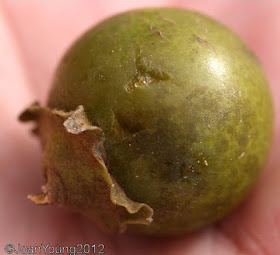Family : Ebenaceae
Diospyros mespiliformis has a fantastic mutualism and symbiotic network with many living organisms, from human beings to small insects. There is a complex ecological system revolving around this tree. It is one of the savanna giants that can live for more than 200 years.
Description
Diospyros mespiliformis is a tall, upright tree that can reach a height of 25 m, with a trunk circumference of more than 5 m. It has a dense evergreen canopy. The bark is black to grey, with a rough texture. The fresh inner skin of the bark is reddish. Leaves are simple, alternate, leathery and dark green. The margin is smooth and new leaves in spring are red, especially in young plants. Flowers are cream-coloured and bell-shaped. Male flowers are arranged in stalked bunches and female flowers are solitary. The fruit is a fleshy berry, with an enlarged calyx, yellow to orange when ripe.
Conservation status
In South Africa the tree is not specifically protected or threatened, but because of its role in the ecosystem and the food web in which it is involved, it definitely deserves some form of protection.
Distribution and habitat
It grows mostly in savanna and woodland, often on termite hills. The tree is widely distributed throughout the eastern part of the African continent, from Ethiopia to the south of Swaziland. It grows well in areas with adequate water and little or no frost.

Ecology
This tree is involved in a unique ecosystem. Different insects such as bees and wasps play a role in pollinating the flowers. Seeds are dispersed either through wash-off by rain or in the droppings of animals that feed on the fruits. Termites often build their nests around the tree and feed on the roots. The tree benefits from moisture and aeration as a result of termites burrowing in the soil under the tree. Snakes like to reside close to or around the tree as they prey on the rodents and certain birds that feed on the fruits.
Some of the animals that feed on the tree are African Green-pigeons, brown-headed parrots, grey hornbills and purple-crested louries, monkeys and baboons. Fallen fruit is eaten by, among others, kudu, impala, nyala and jackal. The leaves are eaten by elephant, kudu and eland. The larvae of the emperor butterfly, Charaxes achaemenes, feed on the leaves of this tree.
Uses and cultural aspects
Ripe fruits are relished by indigenous people, especially by children. Fruits are eaten fresh or are dried for later use. The juvenile twigs are sometimes used as toothbrushes. The wood is durable and used to make spoons and canoes. A decoction of roots is ingested to get rid of internal parasites such as worms. Extracts of various parts of the plants are believed to have antibiotic properties.
Information from: http://www.plantzafrica.com/





